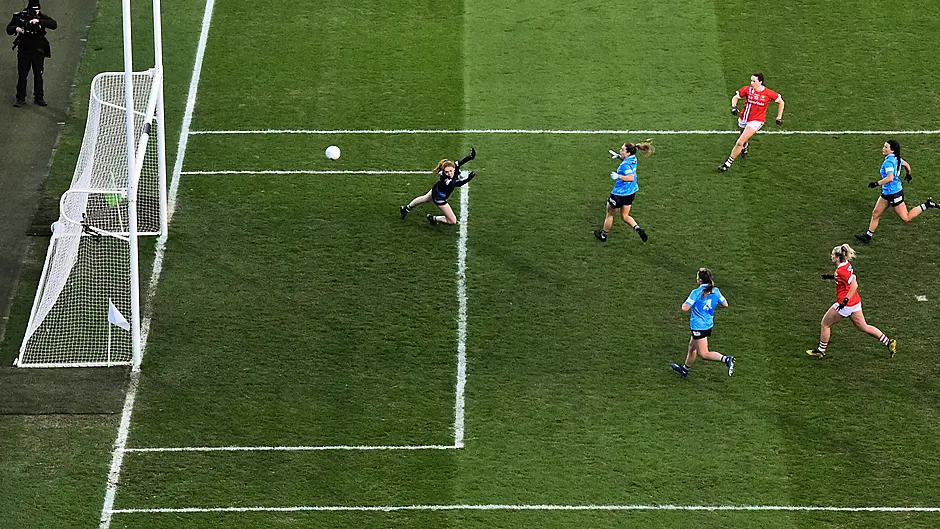NEW Cork football captain Martina O’Brien feels that they’re closing the gap to All-Ireland champions Dublin – but the Rebels’ need for speed could hold the key to catching up with the four-in-a-row winners.
In the days leading up to last December’s All-Ireland final, Doireann O’Sullivan pinpointed Dublin’s athleticism as a reason they’re out ahead of the chasing pack right now.
‘Dublin have taken the pace, strength, and speed of the game to a new level,’ the Cork forward stated – and she was proved right days later when Dublin’s speed and physicality blew the Rebels out of the water in the second half.
From trailing 1-3 to 0-3 at the break, Dublin overran and overpowered Cork in the second period to win 1-10 to 1-5, clinch a fourth All-Ireland senior title in a row and rubberstamp their current dominance on ladies’ football.
Former Waterford footballer Michelle Ryan – now a pundit and analyst on TG4 – wasn’t surprised to see Dublin stretch their legs and pull away from Cork in the second half.
Mick Bohan’s blue juggernaut is the best in the business right now. Just like Kerry bossed the 1980s (1981-90) and Cork dominated for a decade (winning ten out of 11 finals between 2005-16), right now it’s Dublin’s turn. They’ve contested the last seven All-Ireland senior finals, winning the last four and they’re not finished yet. They’ve built an incredibly strong panel and work to incredibly high standards. It means that Ephie Fitzgerald’s Cork has work to do if they want to close that gap and dethrone the Dubs.
‘My dad (former Waterford hurling manager Michael Ryan) has this saying that nothing travels faster than the ball, and Dublin have that done to perfection,’ says Michelle Ryan, who lined out with Waterford for 19 seasons.
She has played against both Cork and Dublin, and highlights the pace Cork play at as an area that they can improve on.
‘Look at the speed and efficiency at which Dublin attack, whereas a lot of other teams are a bit slower in attack and require more of a build-up,’ Ryan explains.
‘Having played against Cork I found they prefer a slightly slower pace. They are very effective at it but they’ll build up quite slowly. Their ball retention is quite good. The likes of Ciara O’Sullivan creates a huge amount but she does it by being a solo runner on the ball. She spends a lot of time on the ball herself and takes on tackles and hits, whereas look at Dublin, you don’t really see their players going off on solo runs and taking on teams. They attack in waves, someone coming off the shoulder, breaking into that space, they make intelligent runs and their attack is potent from a number of different areas.’
That Dublin speed leaves teams gasping for breath, but Cork showed in the early stages of the All-Ireland final that they have the ability to move the ball at pace, too. A move ignited by an Erika O’Shea surge saw Ciara O’Sullivan punch a hole in the Dublin defence, find her sister Doireann who showed quick hands to set-up Áine Terry O’Sullivan, and she rifled the ball into the top left-hand corner of the net for a sensational goal. That’s the attacking intent that can hurt Dublin. Donegal did it against them early in the championship and almost pulled off a shock. Michelle Ryan was at Breffni Park that night to watch it unfold, and saw how Donegal’s speed and physicality rattled Dublin.
‘I was blown away by the speed in which Donegal were playing. Their movement of the ball was very fast and they were creating scoring opportunities because of that,’ Ryan says – and while Donegal threw everything at Dublin they still lost, 2-13 to 2-10. But Donegal ran them close. Armagh came to within five points of Dublin, 3-13 to 3-8, in the All-Ireland semi-final, too. The best that teams can offer now is not good enough to beat Mick Bohan’s team. The Dubs hold all the aces, they’re stronger, fitter and faster (it’s a given that they’ve a very high skillset) but there is a way to ask more questions of them – play at a high intensity and a high pace.
‘If you know a team is physically stronger than you, the biggest thing is to work the ball at speed and you can’t afford to bring it into the tackle. You need runners off your shoulder all the time. It’s a whole give-and-go ball game, whether it’s getting quick ball into the full forward line or driving forward from the half-back line,’ Mayo great Cora Staunton told the Star Sport Podcast ahead of the All-Ireland final.
Cork have speed in different lines. In the half back line Melissa Duggan and Erika O’Shea are quick. Orla Finn is hard to catch, too. Libby Coppinger covers the ground fast as well. When Niamh Cotter came off the bench in the All-Ireland final, her power and pace bothered Dublin.
‘Cork attacked at great pace at the start of that game, there was a bit of space to be exploited in that Dublin back line that isn’t normally there, but Cork found it. They moved that ball fast and it worked,’ Michelle Ryan says, but once Dublin regrouped for the second half it looked ominous for Cork.
‘You can’t take the ball into the tackle against Dublin,’ Ryan adds, ‘I remember what it’s like to get the ball and turn around to have Dublin players in your face. They are relentless. They are as tenacious as they come. Moving the ball at pace is key, but when you do that you are leaving yourself open to a lot more mistakes. You have to be very efficient with that possession, and clinical and accurate. And you need to trust your defence too.
‘If you attack any team with pace it’s hard to counter-act whereas if you slow it down I think Dublin will win it in the physical battle.’
This Dublin team isn’t going away anytime soon. The average age of their starting 15 against Cork was 27 years old. Lynsey Davey, Sinead Aherne, Niamh McAvoy, Sinead Goldrick and Siobhan McGrath might be 30 years old or older, but Lauren Magee, Jennifer Dunne, Aoife Kane are all early 20s. To beat this team, it’s not about waiting for them to dip, it’s about being better than them – and that’s Cork’s challenge.
The Rebels have been in transition in recent years but were more settled in 2020. The mix in the core group is good. Martina O’Brien, Ciara O’Sullivan and Ashling Hutchings are all 30 years old, Orla Finn is 28, while key players like Melissa Duggan (24), Rosin Phelan (26), Hannah Looney (23), Maire O’Callaghan (25), Doireann O’Sullivan (24), Áine O’Sullivan (26), Niamh Cotter (24), Saoirse Noonan (21) and Libby Coppinger (24) will backbone the Rebels’ title charge. Then there’s the younger brigade spearheaded by Erika O’Shea, Daire and Eimear Kiely, Clare O’Shea, etc. Cork are moving in the right direction but they need to build on the progress made in 2020 and make more tweaks.
If Cork find a new top gear then it could also get the best out of a talented attack that has struggled in their recent championship clashes with Dublin. In those last three championship games (2018-20) Cork have scored 2-28, or 0-11 per game. That’s not enough to beat Dublin. Cork’s need for speed is more pressing than ever.
‘I don’t think Cork have to radically change anything. If they can identify the areas in their game – like the speed of releasing the ball and attacking at speed with power – then they can push Dublin,’ Michelle Ryan adds.









